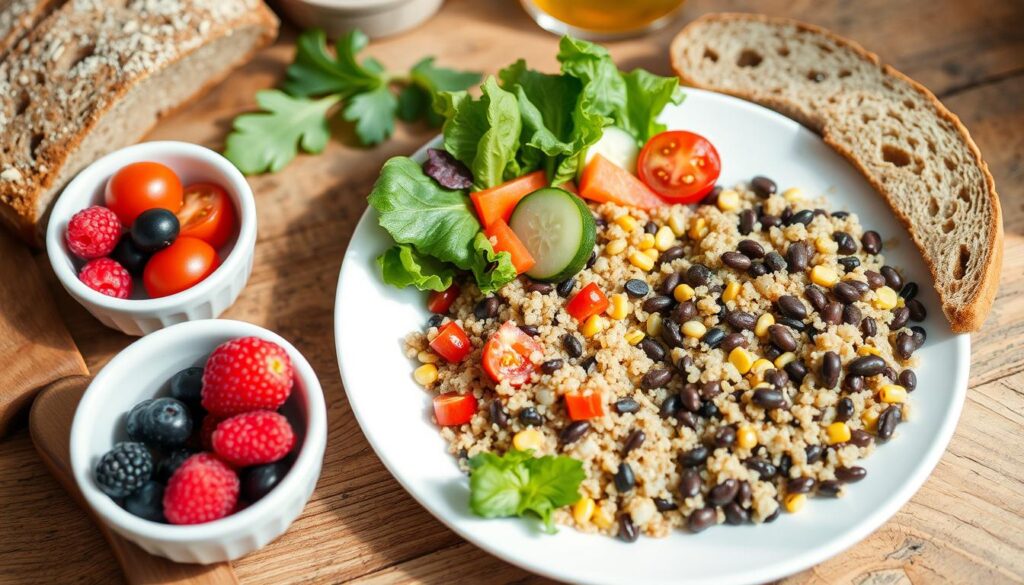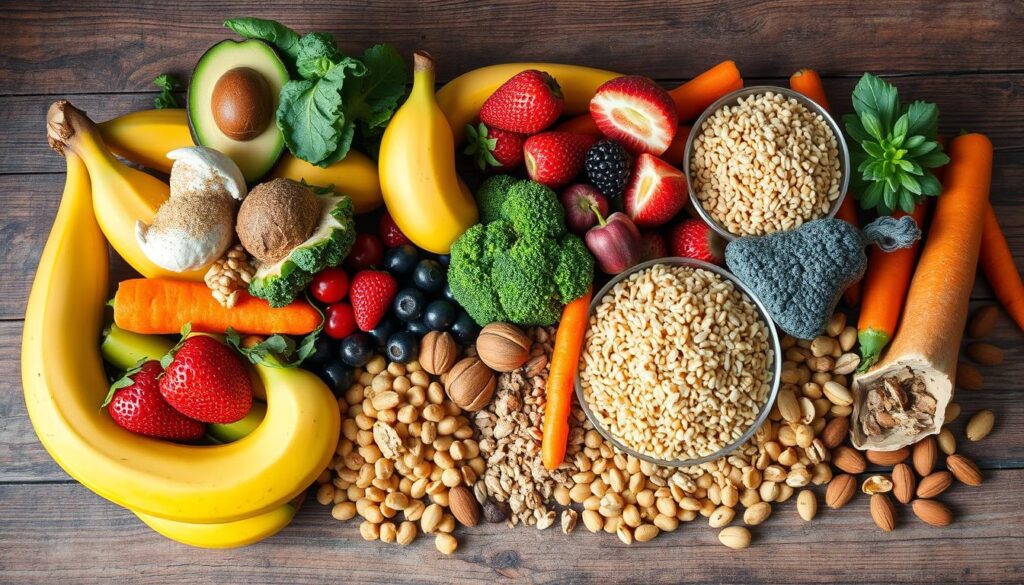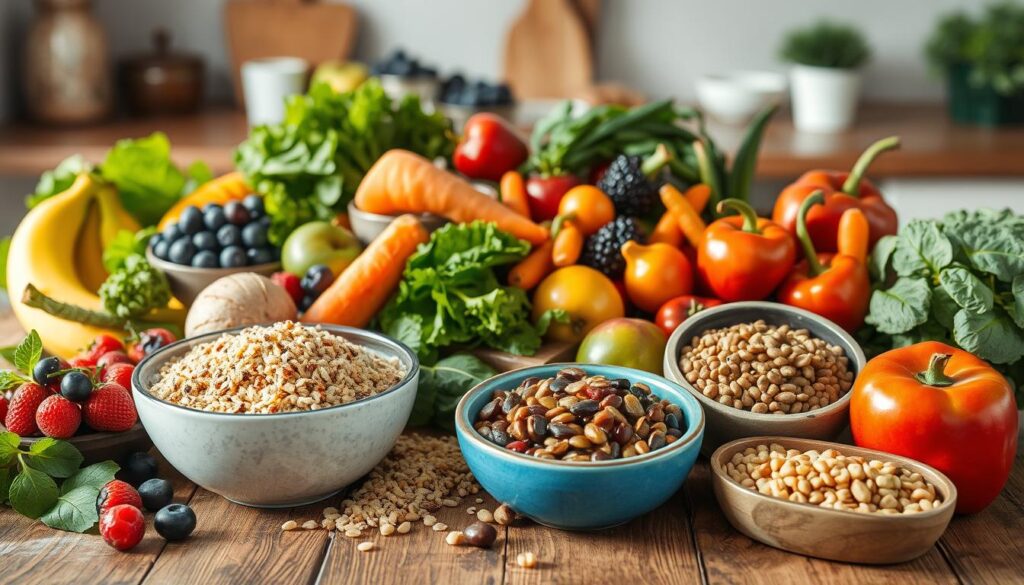Starting a high fiber food plan can change your life. Fiber is in fruits, veggies, and whole grains. It helps your digestion, heart, and weight. But, most Americans only get 16 grams a day, when we need 28.
This guide will show you how fiber can help. You’ll learn to add more fiber to your meals. It’s great for your gut, heart, and weight loss. A high fiber diet is the way to better health.
Key Takeaways
- A high fiber food plan can benefit digestive health, heart health, and weight management.
- The recommended daily fiber intake is 25-35 grams, with a maximum of 40-50 grams.
- Fruits, vegetables, whole grains, legumes, nuts, and seeds are excellent sources of fiber.
- Gradual increases in fiber intake and proper hydration are essential for a smooth transition.
- Meal planning and prepping can help you incorporate more fiber-rich foods into your diet.
Understanding the Importance of Dietary Fiber for Health
Dietary fiber is key for a healthy diet. It helps your body in many ways. It supports gut health nutrition, heart health, and weight management.
Benefits of Fiber for Digestive Health
Fiber keeps your bowel regular. It makes your stool bigger and heavier. This helps avoid constipation, hemorrhoids, and diverticulitis.
A high-fiber diet may also lower the risk of colorectal cancer. It helps keep your bowel movements regular. This reduces the time waste spends in your digestive tract.
Impact on Heart Health and Weight Management
Soluble fiber is found in foods like beans, oats, flaxseed, and oat bran. It helps lower LDL (bad) cholesterol. This reduces the risk of heart disease.
A diet rich in fiber may also lower blood pressure. It decreases inflammation in the body.
High-fiber foods are more filling and have fewer calories. They help you feel full longer. This can aid in weight loss efforts.
Daily Fiber Requirements and Recommendations
The National Academy of Medicine suggests the following daily fiber intake for adults:
- 21 grams for women older than age 50
- 30 grams for men older than age 50
- 38 grams for men age 50 or younger
But, the average American only eats about 16 grams of fiber daily. This is much less than recommended. Eating more fiber-rich foods can greatly benefit your health.
Getting Started with a High Fiber Food Plan
Starting a high-fiber eating plan is great for your health. But, add high-fiber foods slowly to avoid stomach upset. Aim for 2-3 servings of fiber-rich fruits and 3 or more servings of fiber-packed vegetables each day. Also, eat 6-11 servings of whole grains.
Make sure to eat a variety of fruits, vegetables, whole grains, legumes, nuts, and seeds. This is key for a plant-based meal plan. Try making meals like Baked Banana-Nut Oatmeal Cups or Brussels Sprouts Salad with Crunchy Chickpeas. This makes it easier to follow your high-fiber diet.
| Fiber-Rich Food Sources | Serving Size | Fiber Content (grams) |
|---|---|---|
| Raspberries | 1 cup | 8 |
| Broccoli | 1 cup, cooked | 5 |
| Whole Wheat Bread | 1 slice | 3 |
| Lentils | 1/2 cup, cooked | 8 |
| Almonds | 1/4 cup | 4 |
Slowly adding more high-fiber foods to your diet is a smart move. It helps you enjoy the benefits of a plant-based meal plan. This plan supports your health and well-being.
Top Sources of Fiber-Rich Foods
Eating a variety of foods high in fiber is key for a healthy fiber-rich diet. You can find fiber in fruits, veggies, whole grains, and legumes. These foods help you get enough fiber every day. Let’s look at some great sources for your whole food fiber diet.
Fruits and Berries
Fruits and berries are full of fiber. Here are some high-fiber choices:
- Raspberries (8g fiber per cup)
- Pears (5.5g fiber per medium)
- Apples (4.5g fiber per medium)
- Blackberries (7.5g fiber per cup)
- Strawberries (2g fiber per 100g)
Vegetables and Leafy Greens
Leafy greens and veggies are also high in fiber. Try adding these to your meals:
- Green peas (9g fiber per cup)
- Broccoli (5g fiber per cup)
- Brussels sprouts (4.5g fiber per cup)
- Artichokes (14g fiber per cup, cooked)
- Beets (3.8g fiber per cup, raw)
Whole Grains and Cereals
Whole grains and high-fiber cereals can increase your fiber. Check out these options:
- Whole-wheat pasta (7g fiber per cup, cooked)
- Barley (6g fiber per cup, cooked)
- Quinoa (5g fiber per cup, cooked)
- Oats (5g fiber per cup, cooked)
- Popcorn (14.5g fiber per 100g)
Legumes, Nuts, and Seeds
Legumes, nuts, and seeds are also great for fiber. Add these to your fiber-rich diet:
- Lentils (18g fiber per cup, boiled)
- Split peas (16g fiber per cup, boiled)
- Black beans (15g fiber per cup, canned)
- Chia seeds (10g fiber per 2 tablespoons)
- Almonds (6g fiber per 23 almonds)
“Fiber is key for a healthy digestive system and overall health. Eating a variety of fiber-rich foods is good for you. It helps you stay healthy with a prebiotic-rich and whole food fiber diet.”
Creating Balanced High-Fiber Meals
Making a high-fiber meal plan is easy. Just mix different foods high in fiber into your meals and snacks. This way, you get balanced and tasty meals that are good for your health.
Start your day with oatmeal, raspberries, and almonds. It’s a tasty mix with 13.5 grams of fiber. For lunch or dinner, try a bean and veggie salad. It has about 11 grams of fiber.
Make sure to add fiber to every meal and snack. Aim for 10 grams of fiber in main dishes. Also, drink plenty of water all day. Slowly add more fiber to your diet to help your body adjust.
| Fiber Content per Serving | Frequency |
|---|---|
| 7 grams | 2 recipes |
| 13 grams | 5 recipes |
| 21 grams | 1 recipe |
Focus on a high-fiber eating plan and a plant-based meal plan. You’ll enjoy tasty, healthy meals that boost your health. With a bit of creativity and the right ingredients, making high-fiber meals is easy and fun.

“Fiber is the key to a healthy gut, and a healthy gut is the foundation for overall wellness.”
Smart Tips for Increasing Fiber Intake
Adding more fiber to your diet can help a lot. It can make you feel better and keep your heart healthy. But, start slow to avoid stomach problems. These tips will help you add fiber easily and enjoy the benefits.
Gradual Implementation Strategies
It’s key to increase fiber slowly. Try to add 2-3 grams of fiber each week. This slow pace helps your body adjust and avoids discomfort like bloating.
Hydration Requirements
Drinking enough water is also important. Aim for 64 ounces (8 glasses) a day. It helps fiber move well and keeps you regular.
Meal Planning Techniques
- Choose whole-grain foods like brown rice or whole-wheat bread when eating out. Also, ask for extra veggies.
- Check food labels for high-fiber foods. Add them to your meals and snacks.
- Plan your meals ahead. Make sure to include fiber-rich foods at every meal.
- Prepare fiber-rich dishes like lentil soups or quinoa salads for the week. It keeps your fiber intake steady.
Follow these tips to slowly increase your fiber intake. You’ll enjoy many health benefits without stomach issues. A high-fiber diet is a simple way to improve your health.
Common Challenges and Solutions on a High Fiber Diet
Starting a high-fiber diet is great for your gut and health. But, you might face some challenges at first. Don’t worry, with the right tips, you can easily add more fiber to your diet.
Addressing Digestive Discomfort
When you eat more fiber, you might feel increased gas and bloating. This is normal as your body gets used to it. To feel better, slowly add more fiber over weeks instead of all at once. This helps your gut adjust smoothly.
Managing Specific Dietary Needs
If you have diverticular disease, be careful with foods like seeds and nuts. Talk to your doctor or a dietitian to find safe, high-fiber foods for you.
Easing into a High-Fiber Diet
Beginners should start with easy-to-digest foods like oatmeal. Then, add more fiber-rich foods slowly. This way, your body gets used to more fiber without upset.
If you have ongoing or bad digestive problems, see a doctor or dietitian. They can give you advice tailored to your needs and health.
| Fiber Intake Recommendations | Women | Men |
|---|---|---|
| Recommended Daily Fiber | 21-25 grams | 30-38 grams |
| Average Fiber Intake in the U.S. | Around 15 grams per day | |
Listen to your body and make small changes. This way, you can easily add a high-fiber diet to your life. You’ll enjoy the many benefits it brings to your gut health and overall well-being.

Meal Prep and Recipe Ideas for Fiber-Rich Dishes
Starting a high-fiber diet doesn’t mean you have to give up taste. It can actually make your meals more exciting and healthy. Let’s look at some tasty breakfast, lunch, dinner, and snack ideas. These will help you add more fiber to your daily meals.
Breakfast Options
Begin your day with a fiber-rich breakfast. Try Apple Cinnamon Chia Pudding or Baked Banana-Nut Oatmeal Cups. These dishes are not only full of fiber but also packed with nutrients to start your day off right.
Lunch and Dinner Suggestions
For lunch, enjoy a White Bean & Avocado Toast or a Brussels Sprouts Salad with Crunchy Chickpeas. For dinner, go for a Slow-Cooker Turkey Chili with Butternut Squash or a Roasted Pork Tenderloin with Vegetables & Quinoa. These meals are not only high in fiber but also full of flavor and texture.
Healthy Snack Alternatives
Snacking on a high-fiber diet doesn’t have to be dull. Choose fresh fruits, raw veggies with hummus, or a small amount of nuts and seeds. These snacks are rich in fiber and will keep you full and energized.
| Breakfast | Lunch | Dinner | Snacks |
|---|---|---|---|
| Apple Cinnamon Chia Pudding | White Bean & Avocado Toast | Slow-Cooker Turkey Chili with Butternut Squash | Fresh Fruits |
| Baked Banana-Nut Oatmeal Cups | Brussels Sprouts Salad with Crunchy Chickpeas | Roasted Pork Tenderloin with Vegetables & Quinoa | Raw Vegetables with Hummus |
| Nuts and Seeds |
Adding these fiber-rich meals and snacks to your high-fiber eating plan or whole food fiber diet can be tasty. It also boosts your fiber intake. These dishes will fuel your body and support your health.
Special Considerations for Different Dietary Needs
When you follow a high-fiber diet, think about your own needs and health. If you have irritable bowel syndrome (IBS) or diverticulitis, talk to a doctor first. This is because more fiber can sometimes make symptoms worse.
If you have diabetes, choose foods that are high in fiber but low in sugar. Good choices are fruits, veggies, and whole grains. These foods help keep your blood sugar stable and can lower the risk of serious problems. People who can’t eat gluten can still get enough fiber. They can eat foods like quinoa, brown rice, legumes, and many plant-based foods.
Vegetarians and vegans might find it easy to get enough fiber from plants. But, they should make sure their diet is balanced. This avoids missing out on important nutrients. Talking to a dietitian can help make your high-fiber diet better for you.


A Life-Changing Experience with This Weight Loss Supplement (Nagano Tonic)
I’ve always struggled with finding a weight loss solution that actually works for me. Like many, I’ve tried numerous diets, exercise routines, and supplements over the years—some worked for a short time, but nothing ever gave me long-term results. That was until I decided to try the weight loss supplement I found : Link to the Supplement.
From the moment I started using it, I noticed a difference. Not only did I feel more energized, but my cravings also became more manageable. The best part? I started seeing results much quicker than I anticipated! Over the course of just a few weeks, I noticed a significant reduction in belly fat and overall weight loss that I hadn’t been able to achieve before.
What makes this supplement stand out from all the others I’ve tried is how it supports me in my daily routine without any jitters or energy crashes. I’m able to stay focused and motivated, which has made it easier to stay on track with my diet and exercise plan.
This product truly exceeded my expectations, and I feel more confident and healthier than ever before. If you’re struggling with your weight loss journey like I was, I highly recommend giving this supplement a try. It’s been a game-changer for me, and I’m sure it can work wonders for you too!
Contant Them on email .. tonicnagano50@gmail.com
I’ve tried so many weight loss products over the years, but nothing worked like this supplement! Since I started using it, I’ve noticed a big difference in my energy levels and appetite control. In just a few weeks, I’ve lost weight and feel so much better. It’s been easy to stick with, and the results speak for themselves. Highly recommend this to anyone looking to make a real change!
wasn’t sure what to expect, but this weight loss supplement has really impressed me! After just a few weeks of use, I’ve already dropped a few pounds and feel more motivated to stay active. It’s helped curb my cravings and boosted my energy throughout the day. I’m excited to keep going and see even better results. Definitely worth trying!
Reach them on tonicnagano50@gmail.com
I was skeptical at first, but this supplement has truly made a difference in my weight loss journey. I’ve lost weight without feeling deprived or sluggish. My cravings are under control, and I feel more confident in my body. It’s easy to incorporate into my daily routine, and the results speak for themselves. I’m so glad I gave it a try!
Thanks David, i do use the link to make my purchase. you can get too here http://surl.li/iasppy
I’ve tried so many weight loss products, but this one has been by far the most effective. In just a few weeks, I’ve noticed a visible difference in my body and energy levels. It’s helped me stay on track without the constant hunger pangs and cravings. I’m really happy with my progress and can’t wait to see where I’ll be in another month!
This Nagano Tonic has been amazing! In just a few weeks, I’ve lost weight, feel more energized, and my cravings are under control. Highly recommend it!
Thats the link to purchase http://surl.li/iasppy